Have you ever watched your cat sleeping peacefully, and then suddenly noticed a slight twitch in their paws or whiskers?
It’s quite a common sight for cat owners to find their furry companions twitching during sleep. (1)
Before you start worrying about the health of your snoozing kitty, it’s important to understand that twitching is often a normal part of your cat’s sleep process, akin to the way humans might twitch or move in their dreams.
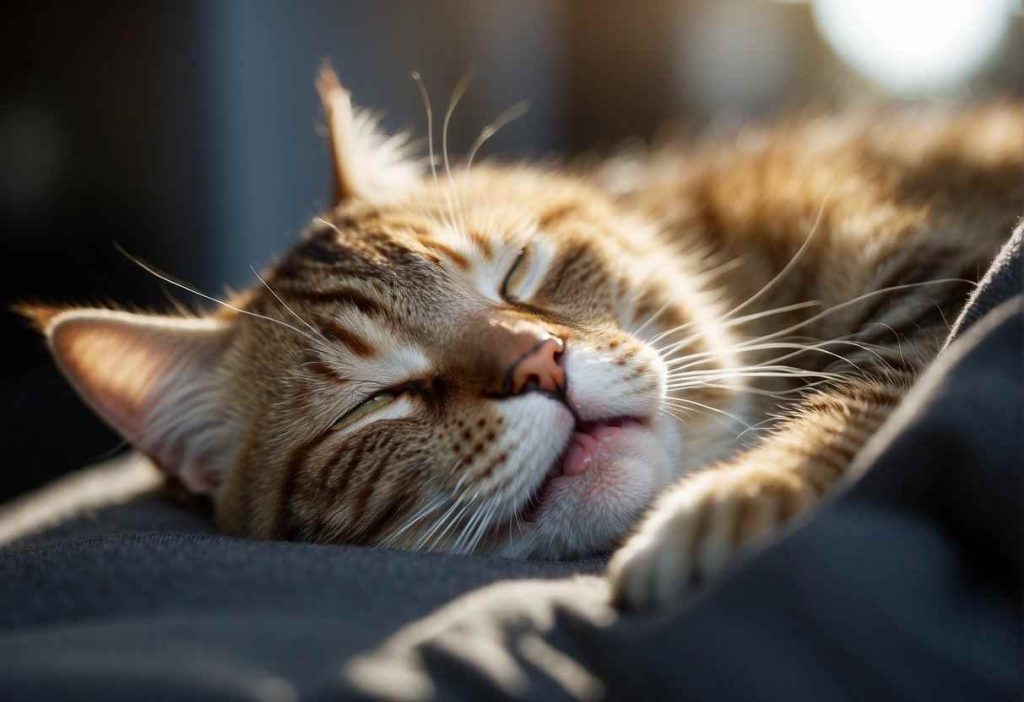
Cats experience different sleep stages, and the twitching you observe is typically associated with the REM (Rapid Eye Movement) phase, where dreaming occurs. (2)
However, not all twitches are created equal, and it’s crucial for you as a cat owner to discern between harmless dream-induced movements and potential signs of distress or neurological disorders.
This article aims to walk you through the nuances of feline twitching during sleep, exploring the reasons behind it, and offering advice on when it might be time to consult a vet.
Along the way, you’ll gain a deeper insight into your cat’s behavior, which in turn can help strengthen the bond you share.
Key Takeaways
- Twitching during sleep is normal for cats, often occurring during the REM stage of sleep.
- Discerning between normal twitches and symptoms of a possible health issue is key.
- Consulting a vet may be necessary if twitching is frequent or accompanied by unusual behaviors.
Understanding Cat Twitching in Sleep
Cats sleep between 12 to 16 hours a day, with their sleep cycles alternating between REM (rapid eye movement) and non-REM stages. (3)
Non-REM sleep is a light dozing phase where they can wake easily—think of it as the cat equivalent of your coffee nap.
In contrast, REM sleep is when dreaming occurs, and this is also where most of the twitching happens! It’s an essential part of their sleep that aids in brain development and memory consolidation.
What Does Cat Twitching Look Like?
When your cat is off in dreamland, you might notice some twitching—a telltale sign of activated sleep. These twitches can be involuntary movements, such as:
- A flick of the tail
- Slight shivering
- Paws paddling as if running
- Whisker or ear twitches
- Gentle jerking of the body
But when should you be concerned? Well, most of this twitching is harmless and a normal behavior.
However, if the twitching is accompanied by more severe symptoms such as difficulty walking, excessive drooling, or seizures upon waking, it might be worth a chat with your vet.
Don’t fret too much, though. Most of the time, these quirky sleep twitches are just your cat’s way of saying they’re deep in dreamland, possibly chasing the dream version of a laser pointer.
So next time you catch your cat snoozing and twitching, rest easy knowing they’re perfectly normal.
Just enjoy the adorable show—but maybe resist the urge to wake them up for a cuddle, alright?
Exploring The Causes of Twitching
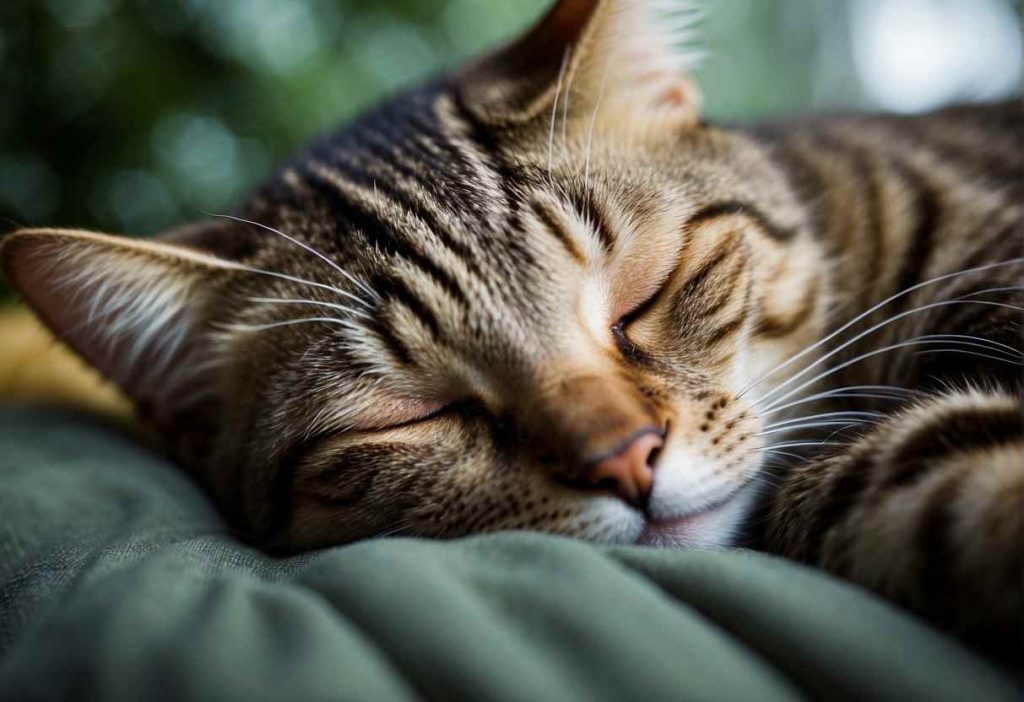
While we can’t ask them what they’re dreaming about, research suggests that animals, including cats, do experience dreams.
These dreams often involve reenacting the day’s events, which could explain the paws paddling or whisker twitching you may observe.
Medical Conditions and Twitching
Muscle Spasms and Neurological Disorders Muscle spasms can be simple reactions to an overly exciting day or may point to more significant health issues such as neurological disorders. (4)
Feline Hyperesthesia Syndrome A condition where your cat may seem excessively twitchy or sensitive to touch, especially along the spine.
Seizures in Cats If twitching is accompanied by more severe symptoms, it could indicate a seizure that requires immediate veterinary attention.
Epilepsy Though less common in cats than in dogs, epilepsy can cause recurring seizures that may be observed as twitching during sleep.
Brain Tumors An underlying brain tumor might also be responsible for sleep-related twitching, highlighting the importance of monitoring your cat’s behavior.
If you notice any abnormal patterns or major changes in your cat’s behavior, it’s best to consult your vet. Remember, you know your furry friend better than anyone, and if something seems off, it’s better to be on the safe side!
Behavioral Insights into Cat Twitching
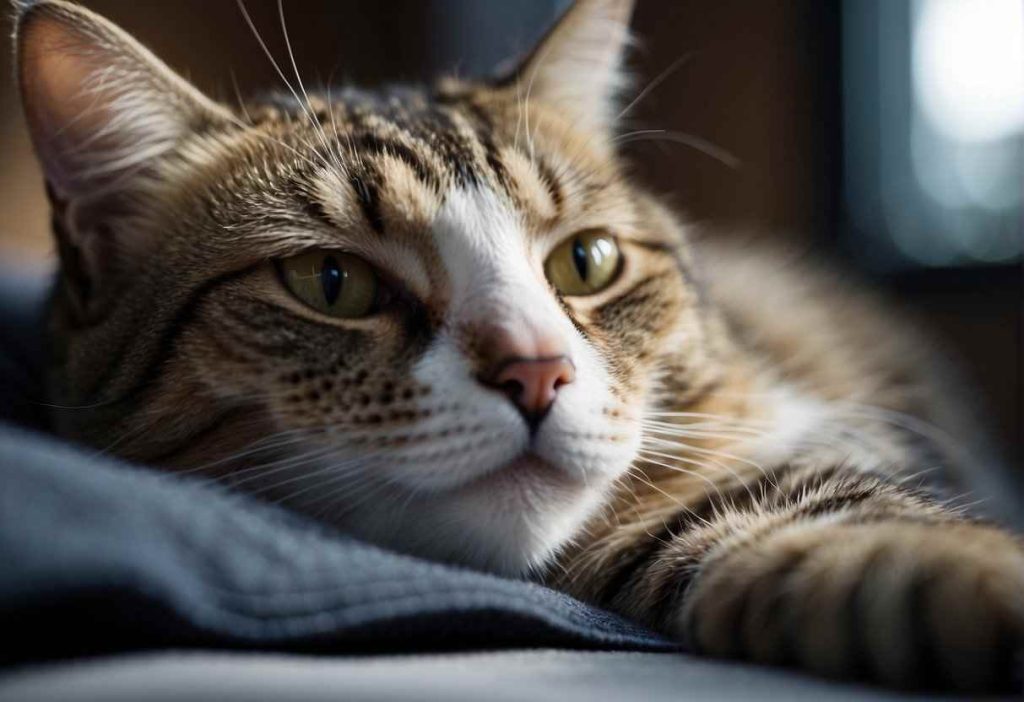
Cats experience various sleep stages, including the REM phase where dreams occur. Imagine your kitty might be dreaming of chasing butterflies or prowling around their kingdom.
It’s usual for them to exhibit twitches during this deep sleep phase, reflecting their brains’ activity.
Interpreting Body Language and Signals
Cats communicate volumes with their body language, even when they’re off in dreamland.
Twitches can be simple reflexes or reactions to dreams, but it’s important to distinguish between normal sleep twitches and ones that might indicate distress. Here’s a quick guide:
- Normal Sleep Twitches: Soft paws paddling, whiskers, or ears twitching gently.
- Distress Signals: Persistent, severe twitches accompanied by meowing or unusual vocalization.
Stress Factors and Health Concerns:
- Stress: Just like you, cats can twitch more when stressed. Check their environment—is it calm or chaotic? (5)
- Toxins: Exposure to harmful substances can lead to spasms. Keep a tidy, toxin-free space for your kitty.
- Allergies & Fleas: Reactive twitching might signal irritation. Flea bites can cause allergic reactions and consequential twitching.
- Ear Mites: These pests aren’t just irritating—they can cause excessive scratching and twitching.
Does your cat shake like a leaf when napping?
It’s likely normal, but keep an eye out. Remember, if your cat’s twitches are paired with more concerning signs—difficulty walking or extreme sensitivity—it’s time for a vet visit.
It’s not just about fleas and stress; it’s about ensuring your furry roommate stays healthy and dreamy.
Improving Relationships Through Understanding Behavior

Noticing your cat’s enigmatic midnight twitches as they nestle into their dreams might first seem odd or potentially worrying.
However, comprehending these behaviors can enhance your connection with your furry friend.
Creating a Stress-Free Environment
Curious about why your feline friend appears jittery, sending tiny twitches through their body? They might not be completely relaxed. As a caring pet owner, consider exploring ways to reduce their stress:
- Set up cozy hideaways where they can snooze without interruption.
- Establish a consistent routine for feeding and playtime to provide a sense of security.
- Limit loud noises or sudden changes that could send their furry little nerves on edge.
- Play soft music or use a pheromone diffuser to create a calming atmosphere. (6)
Creating a comfortable environment isn’t just about fluffing pillows; it’s about nurturing a space that speaks the language of comfort to your cat.
Fostering a Positive and Loving Relationship
Understanding your cat’s twitches can be a fun puzzle. Recognize that mild twitching in sleep typically mirrors the frolics of their daydreams. Here’s how you can use this knowledge to bond:
- Observe how your cat’s sleep twitches correlate with their daily activities and moods.
- Be attentive to changes in their twitching that might hint at discomfort, like excessive twitching or pain.
- Consult a veterinarian if you spot worrisome signs—think loss of consciousness, drooling, lethargy, or persistent odd behavior. (7)
By being a vigilant and caring observer, you’re not just reacting to potential health issues but also reassuring your cat that they’re safe and loved.
Remember, cats don’t come with manuals, and their quirky sleep twitching is just one of their many enigmas.
So next time you’re up late and you catch a glimpse of those little twitches, take a moment to appreciate the complex creature that’s chosen you as their human.
Concerned? Don’t hesitate to reach out for medical attention—otherwise, cherish the twitches as a quirky trait of your unique and mysterious feline pal.
Practical Tips and Solutions for Cat Owners
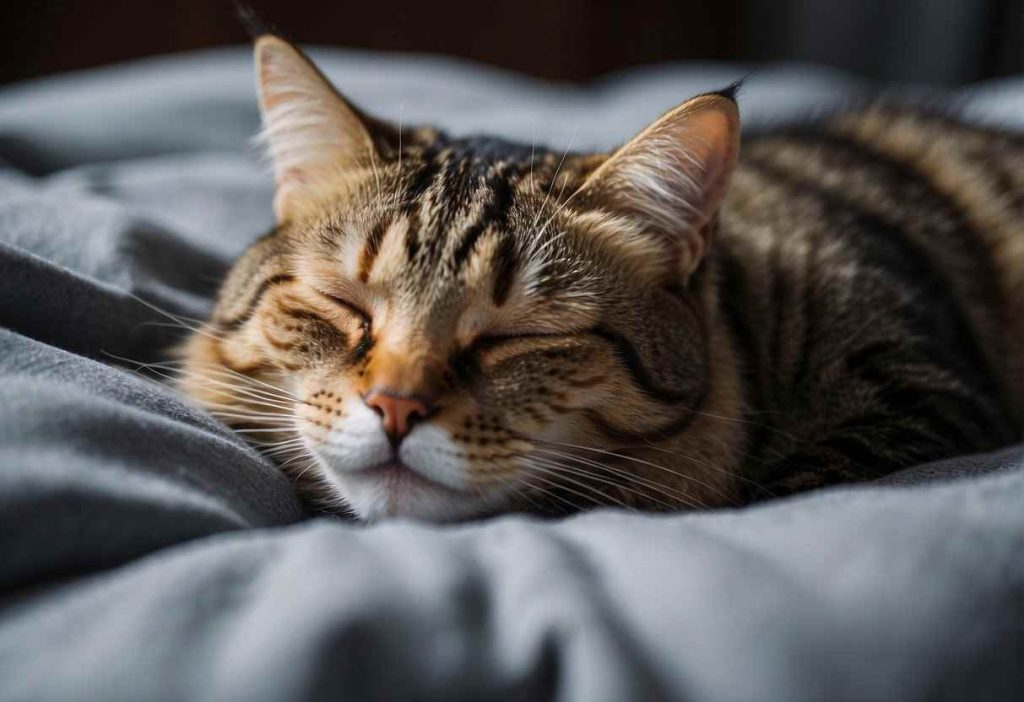
Establishing daily routines helps, and here’s how you can sprinkle in some fun:
- Playtime: Indulge in play sessions before bed; a tired kitty is a happy, twitch-less sleeper.
- Mealtimes: Keep feeding times consistent to avoid upset tummies and midnight munchies.
- Cuddle Time: Gentle pets and chin scratches can relax your cat, leading to peaceful zzzs without a twitch.
Remember, twitching shouldn’t be accompanied by vomiting or other signs of distress like dehydration. If you see those, a vet visit is in order as it could be a sign of toxicity or a health issue.
Making Your Cat Feel Loved and Comfortable
Who doesn’t want the comfiest sleeping nook? Cats are connoisseurs of comfort, and it’s easy to set the stage:
- Superb Sleeping Spots: Ensure your feline has several cozy snooze options away from noise and chaos.
- The Right Bedding: Soft blankets or cushy beds? Both are purr-fect for twitch-free naps.
- Quiet: Maintain a serene ambiance for uninterrupted dream chasing.
Creating a sleep sanctuary is key. Keep their bed away from high-traffic areas to avoid disrupting their catnaps.
If you notice more twitching than usual, try adjusting their space—maybe they prefer a sunny spot or a more secluded corner. You’re the best judge of your cat’s comfort—trust your instincts!
By staying observant and nurturing, you’ll keep those kitty twitches cute and normal, just like their charming quirks!
Humor and Relatability in Cat Ownership

Witnessing the odd shake or sudden “running” motion with their little paws, it’s moments like these that add a dash of humor to pet ownership.
- Medication: Remember, unlike that hilarious attempt to climb the curtains, sleep twitches usually don’t require a trip to the pharmacy.
- Veterinarians: But, if you catch more than the occasional twitch, a chat with your vet can ensure it’s not a sign of something like kidney disease.
- Cat Parents: You’re in a vast community that finds these quirks not just amusing but relatable.
Ever wondered if these sleepy twitches are your cat dreaming of grand adventures? Perhaps, in their slumber, they’re stealthily outwitting that pesky neighborhood squirrel!
Sleep Patterns:
Cats sleep a lot, averaging between 12 to 18 hours a day. That’s plenty of time for sleep shenanigans that pet parents witness, typically in good-natured amusement.
Quirky Behaviors:
- Sudden jolts
- Gentle paw paddling
- Whisker twitches
- Tail flicks
These actions provide a sneak peek into the enchanting world of our cats’ dreams, making every day with them an entertaining one.
So the next time you see your cat twitching away, remember, it’s just one of the many joys of being a pet parent, coupled with the satisfaction that—you guessed it—no one understands your cat quite like you do.
Ensuring Your Cat’s Health and Well-being
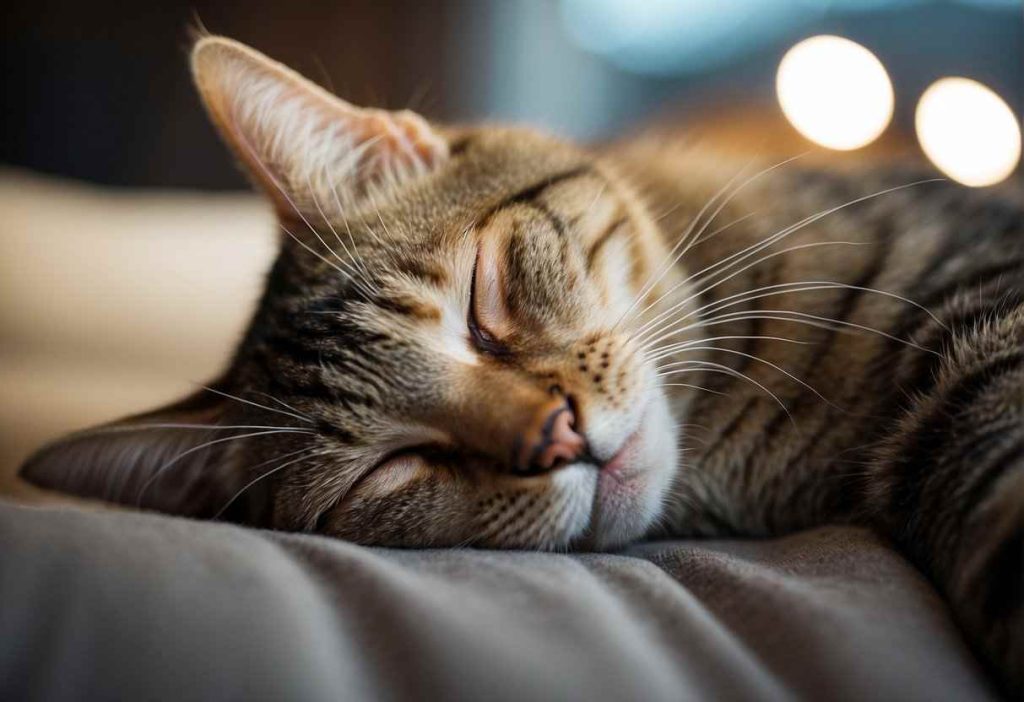
While occasional twitching is normal—thanks to dreams and those busy kitten or older cat nerves—there are times when it could be a signal from their nervous system that they need a bit more care.
Keep an eye out for the unusual: difficulty walking, excessive drooling, seizures, or if they’re overly sensitive near their tail. These symptoms could be whispering secrets about their health that you shouldn’t ignore.
A sudden change in these sleep twitches might indicate it’s time to hop on over to the vet. Remember, it’s better to be the overly cautious cat parent than to miss a cue!
Providing a Stimulating and Nurturing Environment
Curious about how to keep your kitty purring in peaceful slumber? Create a cat haven that ticks all the boxes for mental and physical health!
- Comfort is King: Ensure your kitty has a cozy nook to doze off—a fluffy bed or a sunny spot will do.
- Tickle Their Whiskers: A stimulating playtime before bed can make all the difference. It keeps their body and mind engaged, tiring them out for a restful night’s sleep.
- Routine Reigns: Cats, much like us, relish a good routine. Regular mealtimes and play sessions can provide a sense of security and comfort.
By nurturing your cat’s environment, you’re not just crafting a space of comfort; you’re also ensuring their well-being is aligned with their instincts.
And that, dear friend, is the purr-fect formula for a happy cat!
Quick Recap

As a loving cat owner, you’ll be happy to hear that those sleep twitches are usually totally normal.
Cats clock in a hefty 12 to 18 hours of snooze time daily, and those muscle twitches often happen during their dream-filled REM sleep.
Did You Know?
- Sleep Stages: Cats experience REM sleep, which is where most dreaming occurs.
- Normal Behavior: Twitching might simply be a sign they’re hunting mice in dreamland.
When to Pay Attention:
- Symptoms: Look for twitches paired with difficulty walking, excessive drooling, or sensitivity near the tail.
- Health Indicators: Persistent or severe twitching could hint at underlying health issues like allergies or, in rare cases, more severe conditions.
Why This Matters: Understanding your cat’s twitching patterns can deepen your bond. You’ll learn when they’re blissfully chasing dream birds and when to be concerned.
Remember, a well-observed twitch is a step closer to ensuring your cat’s health and happiness!
- Watch and Learn: Observe their sleep patterns and types of twitches.
- Take Action: Consult a vet if twitching seems off.
Applying these insights could be the key to unlocking an even more harmonious relationship with your cat.
After all, an informed owner is a cat’s best friend. Keep these little nuggets of wisdom in mind next time you catch your buddy in twitchy dreamland!
Frequently Asked Questions
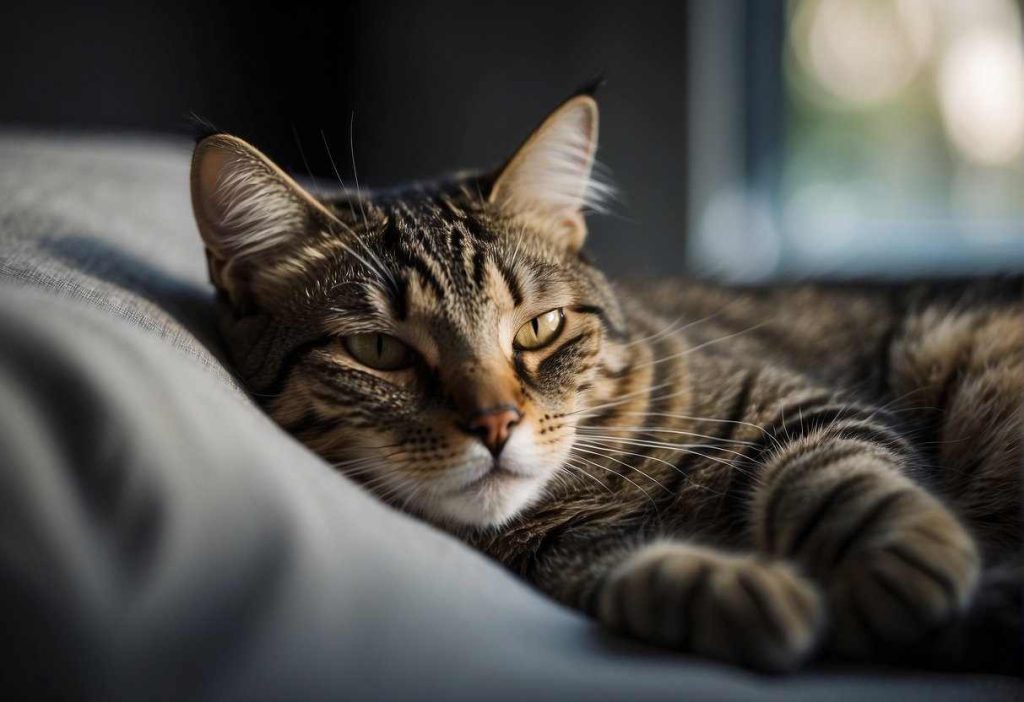
Curious about your cat’s sleeping twitches? Let’s clear up the mysteries with some quick answers to your burning questions.
Is it normal for my cat to twitch while sleeping?
Absolutely! It’s quite common for cats to have mild twitches in their sleep, similar to humans experiencing a twitch or jerk as they drift off.
What does it mean when a cat twitches a lot in their sleep?
Frequent twitching can be a normal part of dream-filled REM sleep or could occasionally signal discomfort from itches, such as flea bites.
Can twitching in sleep indicate my cat is dreaming?
Yes, your furry friend probably is dreaming. Cats, like us, have REM sleep, where they’re most likely to dream and exhibit those cute little twitches.
Should I wake my cat if they are twitching in their sleep?
Nope, it’s best to let sleeping cats lie. Waking them can cause disorientation or stress – unless you suspect they’re in distress, of course.
What are the signs that my cat’s twitching is due to a health issue?
Watch out for additional symptoms like difficulty walking, excessive drooling, seizures, or a tender tail area which can be red flags for health concerns.
How can I help my cat have a more restful sleep?
Ensure they have a comfortable, quiet sleeping area and stay up-to-date with flea prevention to keep itch-inducing pests at bay.


